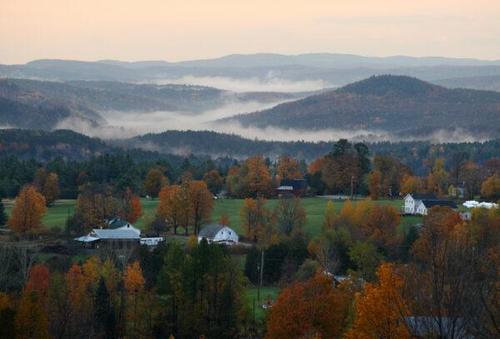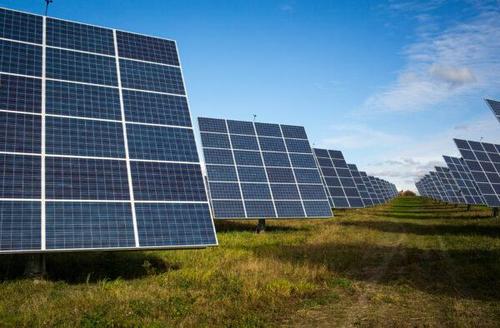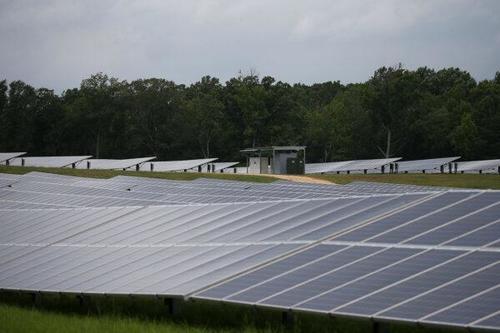This article is the first in a series on the underreported costs of solar power. American farmers express concerns about being crowded off of their property, the potentially permanent loss of good agricultural soil, and the feasibility of combining large solar installations with farmland or pollinator habitats, among other topics.
Authored by Nathan Worcester via The Epoch Times,
“It’s very frustrating to try to protect your farm,” cotton farmer Nancy Caywood told The Epoch Times.

An aerial view of solar panels at the Sutter Greenworks Solar Site in Calverton, N.Y., on Sept. 19, 2021. (Bruce Bennett/Getty Images)
Caywood and her family manage Caywood Farms in rural Casa Grande, Arizona, south of Phoenix in Pinal County. She said they’re under significant pressure to sell their land to large solar companies, which are buying up parcels near their property.
“It’s eyesores to me,” she said.
Caywood said that surveyors and other people are coming onto her family’s land without their permission.
“They’re very bold,” she said, adding that she’s not sure which companies have been intruding on the Caywood property.
Caywood worries about what could happen to the solar installations near her if their parent companies go under. Abengoa, the Spanish company that built Solana Generating Station near Gila Bend, Arizona, recently filed for bankruptcy.
She is also concerned that the land used for solar farms may never be able to be restored to farmland.
Even now, the land her family owns close to the new solar farm is apparently being affected by the massive installation. Caywood’s son Travis measured ambient temperatures on the east end of the family’s farm that were 10 degrees warmer than the rest of the property.
That portion of the property abuts a solar farm identified as Pinal Central Energy Center, LLC, which was developed by NextEra Energy Resources and was described as one of that company’s “investments in Arizona” according to a 2021 presentation by the firm.
Representatives of NextEra Energy Resources didn’t respond to The Epoch Times’ request for comment by press time.
Another nearby solar project, the 2,100-acre Eleven Mile Solar Center, is just across the Arizona State Route 287 from Caywood Farms.

Caywood Farms in rural Casa Grande, Arizona. (caywoodfarms.com)
The project’s website claims it will generate more than 900,000 megawatts of electricity per year from 850,000 solar panels.
The Epoch Times also has reached out to Orsted, the Danish multinational power company that is a partner in the project, for comment on Caywood’s remarks as well as the installation’s projected power output, given longstanding concerns about the real-world efficiency of solar panels.
A spokesperson for the Solar Energy Industries Association, an industry trade organization, offered a different perspective.
“Solar projects and agricultural lands are often highly compatible. Farmers and landowners can gain significant revenue for lands they are not actively farming and projects almost always are conducted to the benefit of both parties,” the spokesperson told The Epoch Times via email.
The spokesperson declined to comment on the specific individual stories described in this article, stating that “we don’t know all the facts.”
Protecting Soil
Caywood isn’t alone in her concerns about the use of good farmland for solar installations.
Annette Smith, executive director of Vermonters for a Clean Environment, told The Epoch Times via email that the protection of prime agricultural soils has been an issue in her New England state.
Vermont law now specifies that primary agricultural soils won’t cease to be defined as such when a solar installation is built on them.
“My goal was to see that using prime ag land for solar should not be an opportunity to have the land ‘switched’ to commercial, industrial, or some other category simply by installing solar panels thereupon,” state Sen. Mark MacDonald, the Democratic lawmaker who drafted the language, told The Epoch Times via email.
In a telephone call, he added that the language was also motivated by prospective improvements in solar panel efficiency.
“In future years, it won’t take as many acres to produce the same amount of electricity,” he said.

Fog settles between hills at daybreak, seen from the Comstock House bed & breakfast/farm in Plainfield, Vt., on Oct. 20, 2007. (STAN HONDA/AFP via Getty Images)
“The dynamic over the years has changed,” Smith told The Epoch Times. She said Vermont’s Republican Gov. Phil Scott has given the state’s scientists more freedom to consider the downsides of solar projects than his predecessor, Democrat Peter Shumlin.
“When Gov. Shumlin was in charge, it was ‘build everything everywhere regardless of impacts,’” Smith said.
In 2014, under Shumlin, one major solar development ended up claiming what Smith called “some of the finest prime agricultural soils in Rutland County, Vermont.”
Despite these concerns, the Public Service Board (PSB) granted the land to Rutland Renewable Energy, LLC, which was owned by the utility-scale solar company groSolar and has since been sold to the French firm EDF Renewables.
In its decision, PSB concluded that the company’s Cold River Project “will not significantly reduce the agricultural potential of the soils found at the Project site.”

An array of 366 solar tracking devices stand in a field in South Burlington, Vt., on Oct. 31, 2014. (Robert Nickelsberg/Getty Images)
The case made it to the Vermont Supreme Court, which upheld the PSB’s decision against opposition from the Town of Rutland and several neighbors.
“The project site contains a variety of primary agricultural soils; the standards prohibit siting a ground-mounted solar facility on primary agricultural soils. The site has not, however, been used for agricultural production for 15 to 20 years,” Justice John Dooley noted in his opinion affirming PSB’s ruling.
The power produced at the Cold River site, which includes 8,820 solar panels, is currently being sold to Green Mountain Power under a multidecade agreement, according to AEP OnSite Partners, which built the array.
Green Mountain Power confirmed to The Epoch Times that it’s still under that power purchase agreement. Representatives of EDF Renewables didn’t respond to a request for comment by press time.
Vermont is one of only 15 states with statewide solar decommissioning requirements, as described in a December 2021 report from the National Renewable Energy Laboratory. Despite the state’s relatively stringent regulation of the energy source, Smith believes the status quo still leaves farmland vulnerable.

A flock of sheep run across a field in Plainfield, Vt., on Oct. 19, 2007. (STAN HONDA/AFP via Getty Images)
“The state of Vermont really hasn’t done much to protect prime ag soils from solar development,” Smith said. “It’s a case-by-case basis and so far it has not been an impediment to approval, as long as it is returned to being prime ag after the project is decommissioned.”
An SEIA spokesperson told The Epoch Times via email that the group supports decommissioning standards “to promote transparency and clarity while encouraging responsible development of solar projects.”
“Solar developers are seeking to optimize among numerous factors including both minimizing impacts to local resources (like prime ag lands) and access to the grid. Developers will choose less productive agricultural land to avoid such conflicts,” the spokesperson wrote.
Downsides
Janet Christensen-Lewis, who owns Puck’s Glen Organic Farm on the Eastern Shore of Maryland, thinks the wider public is only just beginning to grasp the downsides of solar power.
“I think the public consciousness may have been what I was about six years ago,” she told The Epoch Times. “I just wanted to flip a light switch, totally oblivious to all of the consequences of energy production. And then when you’re faced with projects that are coming that are actually going to impact your surroundings, you take a closer look at things.”
“I suspect that if you said to people in New York City that we should take Central Park, which is 800 acres, and cover it with solar panels, they would be aghast,” she said. “What they don’t realize is that 800 acres is pretty much nothing for the solar that’s being put in now. And we’re using that land.”
In September 2021, the Biden administration’s Department of Energy released its Solar Futures Study, which envisioned a maximum solar deployment scenario of more than 16,000 square miles—an area slightly smaller than the states of Massachusetts and Connecticut combined.
That report, like some other solar energy research undertaken in recent years, envisions the “co-location of agriculture and solar energy.” But Christensen-Lewis is skeptical that such “agrivoltaic” technology could be realized at a large scale.

Solar panels at a solar farm owned and operated by Southern Maryland Electric Cooperative Solar LLC, in Hughsville, Md., on Aug. 20, 2015. (Mark Wilson/Getty Images)
“You’re not going to run combines underneath—you’re never going to figure out a way to make that happen underneath solar panels.”
The Solar Futures Study also emphasizes the potential of “solar-pollinator habitats,” which are intended to combine solar panels with pollinator-friendly native plants, ultimately bolstering crop yields while simultaneously producing cleaner energy.
Christensen-Lewis, who already plants wildflowers on her organic farm to encourage pollinators, has her doubts about those habitats as well.
“We always say that when a solar company comes in and puts in their pollinator habitat, it’s three years away from becoming a patch of weeds, and then they’re going to have to use Roundup,” she said. “It’s just a label—it’s just a selling point—and not necessarily a very good one.”
Maryland has set the target of producing 50 percent of its electricity from renewable sources by 2030, increasing the pressure to build more solar in the state’s rural counties. Yet development along the Eastern Shore hasn’t gone without controversy.

A farmer harvests soybeans in Owings, Md., on Oct. 19, 2018. (Mark Wilson/Getty Images)
The Maryland Department of the Environment ruled that Great Bay Solar I, LLC’s solar plant construction sites in Princess Anne, Maryland, violated multiple titles of the state’s environmental law. The department found that Great Bay Solar had disturbed nontidal wetlands at multiple sites, reaching a settlement whereby the company paid the department a $400,000 civil penalty.
Christensen-Lewis was involved in a successful effort to keep a large solar farm out of Kent County, Maryland, where she believes it threatened prime farmland.
Despite these victories, the outlook for many farmers facing pressure from major solar companies remains uncertain.
Caywood, of Caywood Farms in Casa Grande, worries her fourth-generation farm could become “an island” surrounded by utility-scale solar.
“They’re putting it [solar] out here in the rural areas, on our farmland, and in our forests,” Christensen-Lewis said. “That’s land that we see major other purposes for—for feeding people, for making sure that we have environmental protections in place.”
Views: 180
Comment
-
Comment by Dudley G. Gray on January 8, 2022 at 4:52pm
-
Please, somebody post a pictureof the 300,000 array on farmland just east of Farmington Maine on Route 2
© 2026 Created by Webmaster.
Powered by
![]()
You need to be a member of Citizens' Task Force on Wind Power - Maine to add comments!
Join Citizens' Task Force on Wind Power - Maine